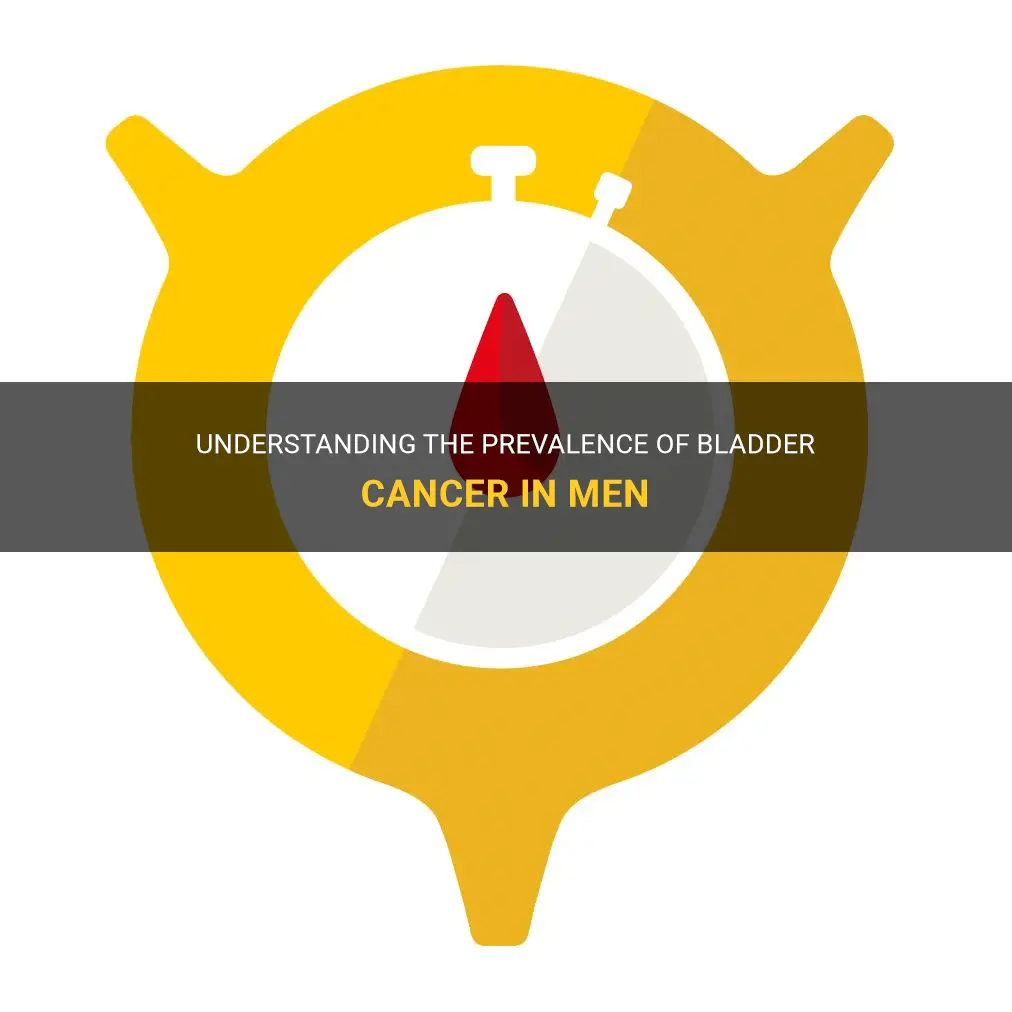
Bladder cancer is a type of cancer that affects the tissues of the bladder, and although it can occur in both men and women, it is much more common in men. In fact, bladder cancer is the fourth most common cancer in men, with over 60,000 new cases diagnosed each year in the United States alone. This alarming statistic highlights the importance of understanding the risk factors, symptoms, and treatment options for bladder cancer, particularly for men who may be at a higher risk of developing this disease.
| Characteristics | Values |
|---|---|
| Incidence | 16 cases per 100,000 men per year |
| Prevalence | 5.3% of all cancers |
| Mortality rate | 4.8 deaths per 100,000 men per year |
| Age at diagnosis | Usually older than 50 years |
| Risk factors | Smoking, exposure to certain chemicals, urinary infections, radiation exposure |
| Symptoms | Blood in urine, frequent urination, pain during urination, back or abdominal pain |
| Diagnostic methods | Urine cytology, cystoscopy, imaging tests, biopsy |
| Treatment options | Surgery, chemotherapy, radiation therapy, immunotherapy |
| Prognosis | Varies depending on the stage and grade of the cancer |
| 5-year survival rate | 77% for localized bladder cancer, 35% for regional spread, 5% for distant spread |
| Recurrence rate | 50-70% within 2 years of initial treatment |
| Prevention strategies | Avoid smoking, drink plenty of fluids, maintain a healthy weight, consume a balanced diet |
What You'll Learn
- What is the prevalence of bladder cancer in men compared to women?
- What are the risk factors that contribute to the development of bladder cancer in men?
- Can lifestyle choices, such as smoking or exposure to certain chemicals, increase the likelihood of developing bladder cancer in men?
- Are there any genetic factors that make men more susceptible to bladder cancer?
- What screening or diagnostic tests are available to detect bladder cancer in men at an early stage?

What is the prevalence of bladder cancer in men compared to women?
Bladder cancer is a common type of cancer that affects the bladder, the organ that stores urine. It occurs when the cells in the bladder grow uncontrollably and form a tumor. While bladder cancer can affect both men and women, there is a significant difference in its prevalence between the two genders.
According to scientific studies, bladder cancer is more common in men as compared to women. In fact, men are three to four times more likely to develop bladder cancer than women. This difference in prevalence can be attributed to various factors, including biological, behavioral, and occupational factors.
One of the main reasons for the higher prevalence of bladder cancer in men is the difference in anatomical structure. Men have a longer urethra than women, which means that urine spends more time in the bladder, increasing the exposure of bladder cells to potentially harmful substances. Moreover, men are more likely to have enlarged prostate glands, which can increase the risk of bladder cancer.
Behavioral factors also play a significant role in the higher prevalence of bladder cancer in men. Smoking, for example, is a major risk factor for bladder cancer, and men have historically had higher rates of smoking than women. This higher prevalence of smoking among men contributes to their increased risk of developing bladder cancer.
Occupational exposure to certain carcinogens is another factor that may explain the higher prevalence of bladder cancer in men. Certain occupations, such as painters, machinists, and truck drivers, involve exposure to chemicals that can increase the risk of bladder cancer. Men are more likely to work in these professions, leading to a higher prevalence of the disease.
While the prevalence of bladder cancer is higher in men, it is important to note that women can still develop the disease. Women who smoke or have a history of exposure to certain chemicals may be at an increased risk. Additionally, advancing age is a risk factor for bladder cancer in both men and women.
In conclusion, bladder cancer is more prevalent in men as compared to women. This difference in prevalence can be attributed to anatomical, behavioral, and occupational factors. Understanding these factors can help in raising awareness and implementing preventive measures to reduce the incidence of bladder cancer in both men and women.
Understanding the Prevalence of Cancerous Bladder Tumors
You may want to see also

What are the risk factors that contribute to the development of bladder cancer in men?
Title: Understanding the Risk Factors for Bladder Cancer in Men
Introduction:
Bladder cancer is the fourth most common cancer in men, with over 80,000 new cases diagnosed each year in the United States alone. While the exact cause of bladder cancer is often unknown, several risk factors have been identified that contribute to its development. This article aims to shed light on these risk factors to raise awareness and promote early detection and prevention strategies.
Smoking:
Tobacco smoking is the most well-established risk factor for bladder cancer, accounting for nearly half of all cases in men. The harmful chemicals in tobacco smoke are absorbed into the bloodstream, filtered by the kidneys, and ultimately excreted in urine, directly exposing the bladder to potential carcinogens. Quitting smoking significantly reduces the risk of developing bladder cancer.
Occupational Exposure:
Certain occupations involving exposure to certain chemicals and substances increase the risk of bladder cancer. Workers in industries such as dyes, rubber, leather, printing, textiles, and paint manufacturing may come into contact with carcinogenic chemicals, such as aromatic amines, benzidine, and arsenic. Taking adequate safety precautions, such as wearing protective equipment, and minimizing direct contact with these substances can help mitigate the risk.
Age:
Bladder cancer is more commonly diagnosed in older men, with the average age of diagnosis being 73 years. Although the exact reason for this correlation is unclear, age-related changes in bladder tissues and longer periods of exposure to risk factors play a role. Regular check-ups and screening tests can help detect bladder cancer at an early stage, improving treatment outcomes.
Chronic Bladder Inflammation:
Repeated urinary tract infections, kidney stones, and certain inflammatory conditions such as interstitial cystitis can cause chronic inflammation of the bladder lining. This inflammation can lead to DNA damage and an increased risk of developing bladder cancer. Prompt treatment of urinary tract infections and regular evaluation of bladder health can help reduce inflammation and minimize the risk.
Genetic Predisposition:
Some individuals have an increased genetic susceptibility to bladder cancer. Certain inherited gene mutations, such as those in the FGFR3 and TP53 genes, can increase the risk of developing the disease. Family history of bladder cancer is also considered a risk factor. Genetic counseling and periodic screening may be recommended for individuals with a family history of bladder cancer to detect any potential abnormalities early on.
Previous Bladder Cancer:
Men who have previously been diagnosed with bladder cancer are at an increased risk of developing it again. Regular follow-ups with a healthcare professional and close monitoring are essential to detect any recurrence and initiate appropriate treatment promptly.
Bladder cancer is a significant health concern for men, but understanding the risk factors can help individuals take proactive steps towards prevention and early detection. Quitting smoking, reducing exposure to carcinogenic substances, maintaining bladder health, periodic screenings, and seeking genetic counseling when appropriate can all contribute to lowering the risk of developing bladder cancer. By being aware of these risk factors, men can prioritize their health and take necessary precautions to reduce their chances of developing this potentially life-threatening disease.
Recurrent Cystitis: Exploring its Connection to Cancer
You may want to see also

Can lifestyle choices, such as smoking or exposure to certain chemicals, increase the likelihood of developing bladder cancer in men?
Bladder cancer is the 6th most commonly diagnosed cancer in men worldwide, and it is estimated that half of all bladder cancer cases are caused by lifestyle and environmental factors. Among these factors, smoking and exposure to certain chemicals have been identified as significant risk factors for developing bladder cancer in men.
Smoking is a well-established risk factor for bladder cancer. Smokers are up to four times more likely to develop bladder cancer compared to non-smokers. This increased risk is attributed to the harmful chemicals present in tobacco smoke, such as aromatic amines and polycyclic aromatic hydrocarbons, which are known to cause DNA damage in the cells lining the bladder.
Exposure to certain occupational and environmental chemicals has also been linked to an increased risk of bladder cancer in men. These chemicals include aromatic amines, such as benzidine and 4-aminobiphenyl, which are commonly found in industries such as dye manufacturing, rubber production, and textile printing. Workers in these industries are at a higher risk of developing bladder cancer due to prolonged exposure to these chemicals.
Furthermore, certain chemotherapy drugs, such as cyclophosphamide and ifosfamide, have been associated with an increased risk of bladder cancer. These drugs are often used to treat various types of cancer, including lymphomas and leukemias. However, their use can result in the production of toxic metabolites that can damage the bladder lining, leading to the development of bladder cancer.
It is important to note that not all individuals with exposure to these risk factors will develop bladder cancer, and there may be other factors involved in the development of the disease. Genetic susceptibility, age, and other lifestyle factors, such as diet and physical activity, can also influence the likelihood of developing bladder cancer.
Prevention and early detection are key in reducing the risk and improving the prognosis of bladder cancer. Quitting smoking is the most effective way to lower the risk of bladder cancer. Additionally, reducing exposure to occupational and environmental chemicals can also help reduce the risk. Workers in high-risk industries should follow safety protocols and wear protective equipment to minimize exposure to harmful chemicals.
Regular check-ups that include urine tests and imaging studies can help in the early detection of bladder cancer. When detected at an early stage, bladder cancer is more likely to be curable or manageable with less invasive treatments.
In conclusion, lifestyle choices such as smoking and exposure to certain chemicals can increase the likelihood of developing bladder cancer in men. Quitting smoking and minimizing exposure to occupational and environmental chemicals are important preventive measures. Regular check-ups and early detection can lead to better outcomes in the management of bladder cancer.
Understanding Bladder Lesions: Causes, Symptoms, and Treatment Options
You may want to see also

Are there any genetic factors that make men more susceptible to bladder cancer?
Bladder cancer is one of the most common cancers worldwide, affecting both men and women. However, research has shown that men are more likely to develop bladder cancer than women, with the male-to-female ratio being approximately 3:1. This discrepancy has led scientists to investigate whether genetic factors play a role in making men more susceptible to bladder cancer.
Several genetic factors have been identified that may contribute to the increased susceptibility of men to bladder cancer. One such factor is a gene called FGFR3. Studies have shown that mutations in this gene are more prevalent in men with bladder cancer compared to women. FGFR3 is involved in cell growth and differentiation, and mutations in this gene can lead to uncontrolled cell growth and the development of cancer.
Another genetic factor that has been associated with an increased risk of bladder cancer in men is the NOD2 gene. This gene is involved in the immune response and inflammation, and variations in the NOD2 gene have been found to increase the likelihood of developing bladder cancer in men. This suggests that the immune system may play a role in the development of bladder cancer in men.
In addition to these specific genes, several genome-wide association studies (GWAS) have identified common genetic variations that are associated with an increased risk of bladder cancer in men. These variations are found in regions of the genome that are involved in DNA repair, cell cycle control, and other cellular processes. It is thought that these variations may affect the ability of cells to repair DNA damage, leading to an increased risk of bladder cancer.
While these genetic factors may contribute to the increased susceptibility of men to bladder cancer, it is important to note that they are not the sole determinants of a person's risk. Environmental factors, such as smoking and exposure to certain chemicals, also play a significant role in the development of bladder cancer. Additionally, genetic factors may interact with environmental factors to increase the risk of bladder cancer in susceptible individuals.
In conclusion, there are several genetic factors that may make men more susceptible to bladder cancer. Mutations in genes such as FGFR3 and variations in the NOD2 gene have been associated with an increased risk of bladder cancer in men. Additionally, common genetic variations identified through GWAS have been linked to an increased risk of bladder cancer in men. However, it is important to remember that genetic factors are not the only determinants of bladder cancer risk, and environmental factors also play a significant role. Further research is needed to fully understand the complex interplay between genetics and the environment in the development of bladder cancer.
Understanding the Link Between Bladder Wall Thickening and Cancer
You may want to see also

What screening or diagnostic tests are available to detect bladder cancer in men at an early stage?
Bladder cancer is a type of cancer that starts in the cells of the bladder. It is more common in men than in women, and early detection is crucial for successful treatment. Fortunately, there are several screening and diagnostic tests available to detect bladder cancer in men at an early stage. These tests include:
- Urine tests: One of the simplest and most common tests used to detect bladder cancer is a urine test. This test involves analyzing a sample of urine for the presence of cancer cells or other abnormal substances. The presence of blood in the urine, known as hematuria, is often an early sign of bladder cancer.
- Cystoscopy: Cystoscopy is a procedure that allows a doctor to examine the inside of the bladder using a thin, flexible tube called a cystoscope. This test can be used to detect tumors or other abnormalities in the bladder. During a cystoscopy, the doctor may also take a small sample of tissue for further testing, a process known as a biopsy.
- Imaging tests: Various imaging tests can be used to detect bladder cancer and determine its size and spread. These tests may include computed tomography (CT) scans, magnetic resonance imaging (MRI), or ultrasound. These tests provide a detailed view of the bladder and surrounding tissues, helping doctors diagnose and stage bladder cancer.
- Urine cytology: Urine cytology is a test that examines urine under a microscope to look for abnormal cells that may indicate bladder cancer. This test is particularly useful for detecting high-grade tumors and is often used in conjunction with other diagnostic tests.
- Molecular tests: Molecular tests, such as fluorescence in situ hybridization (FISH) or immunohistochemistry, can detect specific genetic or protein markers associated with bladder cancer. These tests can be used to determine the risk of recurrence or progression of the disease and guide treatment decisions.
It is important to note that not all men need to undergo screening for bladder cancer. Screening is typically recommended for individuals with a higher risk of developing the disease, such as smokers, those with a family history of bladder cancer, or those with a history of exposure to certain chemicals or substances.
In conclusion, there are several screening and diagnostic tests available to detect bladder cancer in men at an early stage. These tests include urine tests, cystoscopy, imaging tests, urine cytology, and molecular tests. If you are at an increased risk of bladder cancer, it is important to discuss your screening options with your healthcare provider. Early detection can significantly improve the chances of successful treatment and recovery.
Bladder Cancer and Back Pain: Exploring the Connection
You may want to see also
Frequently asked questions
Bladder cancer is more common in men than in women. In fact, men are about four times more likely to develop bladder cancer than women. It is estimated that around 80% of bladder cancer cases occur in men.
Several factors can increase the risk of developing bladder cancer in men. Smoking is one of the most significant risk factors, as it is estimated that up to 50% of bladder cancer cases in men are caused by smoking. Other risk factors include exposure to certain chemicals and substances, such as occupational exposure to dyes, paints, or certain industrial chemicals. Age is also a factor, as the risk of bladder cancer increases with age.
While bladder cancer cannot be completely prevented, there are steps that men can take to reduce their risk. Quitting smoking is one of the most important steps, as it significantly lowers the risk of developing bladder cancer. Avoiding exposure to chemicals and substances known to increase the risk, such as those found in certain occupations, can also help reduce the chances of developing the disease. In addition, maintaining a healthy lifestyle, including regular exercise and a balanced diet, may help lower the risk of bladder cancer.







